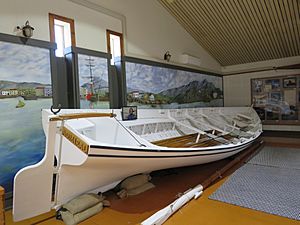Admiral (waterman's boat) facts for kids
The Admiral was a special boat built in Tasmania, Australia. It was used by a waterman (someone who operates a boat for transport) to carry people and goods around Hobart on the Derwent River. This was before any bridges were built across the river.
Contents
The Admiral: Tasmania's Historic Ferry Boat
Building and First Journeys
The Admiral was built and launched in 1865 by a boat-builder named Thomas Morland. He was also a waterman. Later, another waterman, Charles Dillon, bought the boat.
This boat was 8.5 meters (28 feet) long and had eight oars. It was built using a special method called carvel-planked, which means its wooden planks lay smoothly next to each other. The wood used was Huon Pine, and its main support beam (called a keel) was made from Blue Gum wood.
In its early days, besides its regular ferry trips, the Admiral also took part in many Hobart Regattas. These are boat races and events. It often carried important people, like the Premier of Tasmania (the state leader) Richard Dry, and at least three Governors of Tasmania (representatives of the King or Queen): Thomas Gore Browne, Charles Du Cane, and Frederick Weld.
In 1885, the Admiral was carrying the Mayor and other city officials to visit a French warship called the 'Maigon'. Suddenly, another boat, the 'Result', turned sharply around a pier. The Admiral crashed into the 'Result' at full speed.
A few years later, in 1888, the Admiral was made even better. Thomas Morland and Charles Dillon made its hull (the main body of the boat) longer. An engineer named Mr. Patterson then installed a steam engine in the boat.
New Names and New Jobs
Around 1907, the Admiral was given a new name: the Myra. For the next 70 years, it worked as a fishing boat.
In the early 1970s, the boat was renamed again, this time to the Nullia. It was also fitted with a diesel engine. By the late 1970s, the boat was almost destroyed. This happened after an attempt to change its front shape (called a clipper-bow conversion) went wrong in a place called Kettering. Luckily, Allister Martin from the Vintage Boat Club of Tasmania saved it from being burned.
The boat was then restored by Bruce Hills and was once again called the 'Myra'. In 1986, it was sold to a new owner in Sydney. Not much is known about the boat's life after that until 2006.
Bringing the Admiral Back to Life
In 2006, the Admiral was found in a very bad state in a boatyard in New South Wales. It was abandoned and falling apart. John and Susan Dikeman discovered it.
From 2006 to 2009, the Admiral was carefully restored. A team, jokingly called the 'Admiralty', worked to make it seaworthy again (meaning it was safe to travel on the water). This team was started by Bern Cuthbertson, who had received an important award (AO).
The boat was taken apart, and the original Huon Pine planks, nails, and rivets were saved. The old Blue Gum keel was rotten and had to be replaced. The new keel was made from layers of Celery Top pine planks glued together. The old paint and tar were cleaned off the original planks. Then, the boat was put back together using these cleaned parts and new sections made from steamed Huon pine.
A Well-Deserved Retirement
In 2020, the Admiral officially retired from active use. It is now on display at the Bass And Flinders Maritime Museum in George Town, Tasmania. The boat's official welcome ceremony to the museum was delayed because of COVID-19 safety rules. The ceremony finally took place in 2021.



